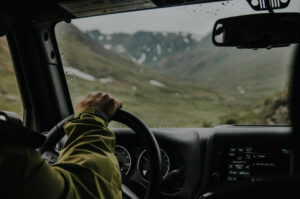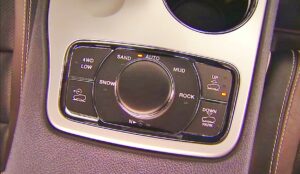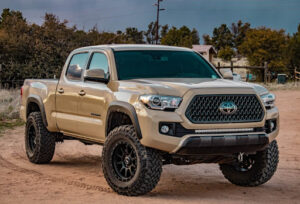Driving jeep wranglers in rain is a thing that wrangler owners face different types of problems. Main problem is hydroplaning and sliding on tarmac roads. This can happen due to various reasons. Some are very simple things you can solve easily.
In this guide I’ll give you a better understanding of things which will cause hydroplaning and how to improve traction of your jeep on wet surfaces for safe ride.
According to experts, a jeep or any vehicle has a higher chance to hydroplane at speeds greater than 35mph in rainy conditions. Slow down your vehicle when it starts to rain or the road is wet.
Contents
Are jeeps bad in the rain?
No jeeps work fine with rain and slippery conditions, if your jeep has proper measures that suit for wet conditions. Jeeps are born to tackle extreme terrains and weather conditions. Jeeps are not bad in the rain.
Now you may think: What are those proper measures? Actually there are a few things you should be aware of, If you are driving in heavy rain with your jeep.
First thing is your tires. When talking about tires it doesn’t mean only the condition of the tire, whether it is new or worn out.
Tire pressure.
Tire pressure is also a leading factor when it comes to driving in wet conditions.
You should have to maintain a proper tire pressure to avoid unnecessary sliding of your wrangler in wet tarmac roads. This tire pressure should be selected according to your tire type and the size.
Normally I run with tire pressure of 28 psi on slippery tarmac roads. That tire pressure works well for me.
If you are running with high psi’s I suggest you drop the tire pressure a bit when driving on wet and check how it works. You’ll amazed with the results;
With that, keep in mind not to reduce tire pressures for very low levels. Underinflated tires also can lead to slipping on wet.
Below has a quick reference to tire pressures according to the height of the tire.
| Tire height | Tire pressure |
| 30” | 29 PSI |
| 31” | 28 PSI |
| 32” | 27 PSI |
| 33” | 26 PSI |
(If jeep is fully loaded with gears or passengers you can increase the tire pressure slightly from the above values from about 1PSI or 2PSI)
Tire type.
Shape of the tire is the next major factor which will decide the amount of grip made in wet surfaces. Thread patterns and the space between thread patterns play a huge role when driving a jeep in rain.
“Wider tires are easier to hydroplane than narrow one.”
I thought it’s better to tell you briefly what’s happening under your tires, when driving your jeep on a rainy day on a tarmac road. Then you may be able to implement things in this guide wisely according to your situations.
How does hydroplaning occur in my jeep?
When you drive on a rainy day, your tires are scattering water from it’s path and trying to grip the road surface.
Water pressure (and level) in front of the tire is higher than the back of the tire at this time.
so that water floors under the tire surface making a thin layer of water between tire and the road surface. (Some amount of water will scatter from the two sides of the tire. But here we are talking about the water directly under the tire surface)
Thread spaces on the tire surfaces work like ruts to flow that water under the tire and keep the grip between road and tire threads.
If your jeep tires have worn out and there are no threads, then there are no ruts to flow that water under the tire.
Then that thin layer of water between your tire and road surface will easily slip your wheel and slide your jeep.
The same thing happens if you drive your jeep too fast on a rainy day.
Then even if your tires have good thread spaces, those thread spaces will not be able to remove water quickly equivalent to your vehicle’s speed.
Then also that thin layer of water can create between your wheel and the road surface and hydroplane your jeep.
I think with this simple explanation you got some idea about how hydroplaning occurs.
With those facts in mind now let’s see about tire types.
What jeep tires best for rain?
With personal experience I can recommend Goodyear duratrac tires for jeeps. It performs excellent in rain as well as most of the weather conditions (including snow!!)
Apart from that I’ve read in forums that BF Goodrich KO2 tires also work well for jeeps in rain. Most users found that KO2 performs in most of the weather conditions without any issue.
I can’t do a comparison between these two because I haven’t used the KO2 tires.
There may be other tire brands that work fine in rain. I mentioned above two tires If you are searching for a better tire to put into your jeep in the future.
Despite which tire you are using the tire pressure as well as depth of the thread plays a major role in wet weather performance.
So I suggest you test your tires performance with changing tire pressures a bit as I mentioned earlier in this guide.
Other factors that can ease jeep hydroplane.
If you compare a Wrangler with a street car, a Jeep Wrangler may slide in the rain more than a car. That’s because jeeps have a different weight transferring mechanism compared to cars.
Cars have a lower center of gravity as well as different suspension mechanisms like independent front suspensions.
Jeeps have higher center of gravity (COG) as well as solid axles. Because of that when cornering in wet conditions jeeps can get into sliding or fishtailing than a car.
Do modifications increase hydroplaning?
Jeep modifications and suspension modifications like lifting will not play a major role in jeep hydroplaning or sliding in rain. But they also can contribute to sliding for some jeeps due to changing of COG.
If you have a good tire set and suitable tire pressure in them, but still you noticed unusual sliding issues while driving or cornering in wet conditions it may be due to issues with your mechanical components like suspensions.
So it’s better to check your vehicle with the help of a mechanical expert in jeeps to find it.
How to improve traction in jeeps when it rains.
Up to now I have told you tips to improve traction of your jeep when it rains. But let’s recap them while adding a few other tips to them.
- Put a proper set of tires to your jeep which gives better traction in the rain.
As I mentioned previously Goodyear duratrac tire, BF Goodrich KO2 tire have better user experiences in this case.
“Most of the mud terrain tires are Perform worse in rain on highways.”
Goodyear wrangler DuraTrac tire

Check Details on Amazon
BF Goodrich KO2 tire

Check Details on Amazon
- Check the threads of the tires
Even if you have a good set of tires that gives better traction in wet, they may have worn out. You can check the depth of the threads by using a coin to get an idea about the depth.
Another thing is the date the tire was made. With time rubber will harden and reduce the grip over time. Because of that even if you have a good depth in threads jeep can hydroplane/ slide in wet conditions.
- Check the tire pressure.
This is a very important fact for hydroplaning. You should keep a proper tire pressure to get better traction in the wet.
- Drive slow
With higher speeds there’s a greater chance to create a layer of water between tire and road surface easily. Because of that, the jeep can hydroplane easily at higher speeds than at slow speeds. So that keeps your speed low in the wet.
- Increase load
According to physics increasing load can improve the frictional force creating to the tires from the road. Because of that, increasing load will reduce the sliding or hydroplaning of your jeep in the wet.
Is using 4wd in rain is necessary for jeep wranglers?
This is a somewhat debatable topic. Some are saying it’s better to use 4wd in the rain while many others say it’s not necessary.
But I stick with the rule below when using 4WD.
“If I can still see the pavement it’s staying in 2wd.”
Because, if the jeep is hydroplaning, at that time tires are not even touching the ground.( There is a layer of water between tire and road surface.) So it makes no difference whether you have more driving wheels at that time.
That means even if I was driving in 4WD mode in an instance of hydroplaning, my tires don’t have the grip due to that layer of water between my tires and road. So my 4WD mode can’t save my jeep from sliding.
Another fact is, on tarmac roads transfer case binding can also happen. I have written separate guide about this 4WD binding issue. You can read that if you want more idea about this.
Some states have roads with lots of oils when it rains. In those kinds of instances, 4WD may be able to improve traction to some extent.
But normally I’m not using a 4WD in a wrangler in the rain on tarmac roads. It hasn’t made visible improvement of the traction for me.
Wrapping up.
With the above guide you can see that you can improve traction and reduce sliding/ hydroplaning in rain by slowing down speed, keeping a proper tire pressure and selecting a proper set of tires.
If you think this guide may be helpful for someone else you can share this with them. You just have to hit the share button below!!
Peace!



